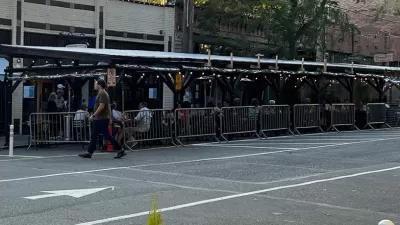Allison Arieff tells the sordid tale of a "modestly modernist" house in Oakwood, a historic district in Raleigh, North Carolina. Despite the fully permitted house being 85 percent complete, a lawsuit by a neighbor could force its demolition.

In examining the example of the lawsuit over the construction, and subsequent legal controversy, of a modernist house in a historic neighborhood in Raleigh, Arieff, writing for the New York Times, asks a troubling question: "should a difference in taste lead to a court date?
The back story:
"In September, Louis Cherry, an architect here, received a building permit and the necessary approvals to begin constructing a house for himself and his wife, Marsha Gordon, on an empty lot in Oakwood, a historic district in Raleigh. The neighborhood features a variety of architectural styles, from postwar bungalows to Greek Revivals, shotguns to Queen Annes. Construction began in October and the home, modern but modestly so, is nearly complete."
However, "[through] a series of protracted appeals, the neighbor has been successful in getting the city to reverse its approval of Mr. Cherry’s permit. The house passed its building inspections and is 85 percent complete, yet sits empty, its future dependent on who finally wins a legal battle that never should have been allowed to happen."
The implications of the case include a loss of individual freedom for the making of one's home, but Arieff also discusses the implications (read: "black eye") of the court case for the preferred methods of historic preservation. For the record, Preservation North Carolina has publically opposed the lawsuit.
FULL STORY: Don’t Like Your Neighbors’ House? Sue Them.

Planetizen Federal Action Tracker
A weekly monitor of how Trump’s orders and actions are impacting planners and planning in America.

Maui's Vacation Rental Debate Turns Ugly
Verbal attacks, misinformation campaigns and fistfights plague a high-stakes debate to convert thousands of vacation rentals into long-term housing.

San Francisco Suspends Traffic Calming Amidst Record Deaths
Citing “a challenging fiscal landscape,” the city will cease the program on the heels of 42 traffic deaths, including 24 pedestrians.

Amtrak Rolls Out New Orleans to Alabama “Mardi Gras” Train
The new service will operate morning and evening departures between Mobile and New Orleans.

The Subversive Car-Free Guide to Trump's Great American Road Trip
Car-free ways to access Chicagoland’s best tourist attractions.

San Antonio and Austin are Fusing Into one Massive Megaregion
The region spanning the two central Texas cities is growing fast, posing challenges for local infrastructure and water supplies.
Urban Design for Planners 1: Software Tools
This six-course series explores essential urban design concepts using open source software and equips planners with the tools they need to participate fully in the urban design process.
Planning for Universal Design
Learn the tools for implementing Universal Design in planning regulations.
Heyer Gruel & Associates PA
JM Goldson LLC
Custer County Colorado
City of Camden Redevelopment Agency
City of Astoria
Transportation Research & Education Center (TREC) at Portland State University
Jefferson Parish Government
Camden Redevelopment Agency
City of Claremont





























